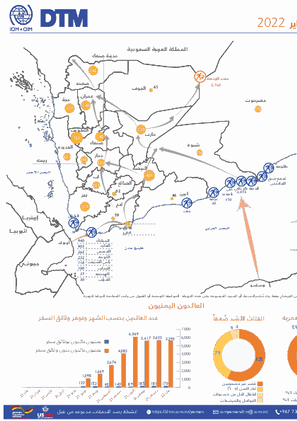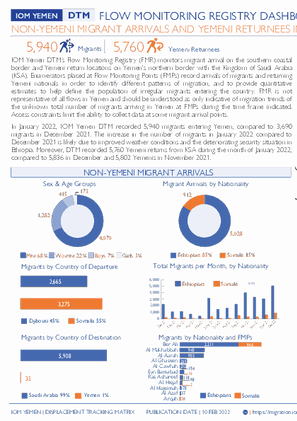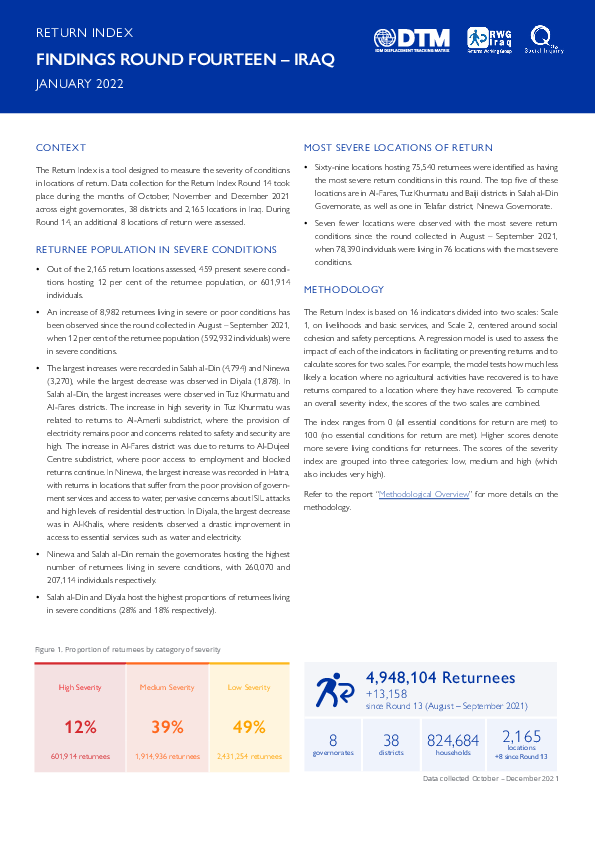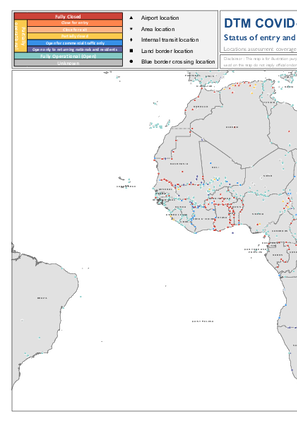-
Countries
-
Data and Analysis
-
Special Focus
-
Crisis Responses
The current outbreak of COVID-19 has affected global mobility in complex and unprecedented ways in the form of various travel restrictions, suspension of air travel, and border closures. To better understand this, the International Organization for Migration (IOM) has developed a global mobility database to map these impacts on human mobility, across global, regional, and country levels. Furthermore, COVID-19 has had a disproportionate impact on vulnerable populations in camps and camp-like settings as well as exacerbated the vulnerabilities of mobile populations who may now be stranded owing to COVID-19 related mobility restrictions. This data is particularly important when addressing specific needs faced by migrants and mobile populations.
IOM has developed a global mobility database mapping the status of different Points of Entry (PoE) and Key Locations of Internal Mobility, globally. These include airports, land border crossing points (could be rail or road), blue border crossing points (sea, river or lake), internal transit points, and areas of interest. For each point of entry, data is collected on the type of restriction, measured applied, and the timeframe, as well as the population category that may be affected by the restrictive measures. This workstream uses direct input from IOM missions and this dashboard displays regularly updated mobility restrictions at the location level.

Contact
DTM Nigeria, AllUsersInDTMNigeria@iom.int
Language
English
Location
Nigeria
Period Covered
Jan 31 2022
Feb 06 2022
Activity
- Event Tracking
- Mobility Tracking
Between 31st January and 6th February 2022, a total of 2,140 movements were recorded in Adamawa and Borno States. The recorded movements consisted of 1,966 arrivals and 174 departures. Arrivals were recorded at locations in Askira/Uba, Bama, Biu, Gwoza, Monguno and Ngala Local Government Areas (LGAs) of the most conflict-affected Borno State and in Girei, Gombi, Hong, Lamurde, Maiha, Michika, Mubi South, Numan, Song, Yola North and Yola South LGAs of Adamawa State.
Departures were recorded in Askira/Uba LGA of Borno, while in Fufore, Michika, Mubi North and Mubi South, Numan and Song LGAs of Adamawa State.

Contact
DTM Nigeria, AllUsersInDTMNigeria@iom.int
Language
English
Location
Nigeria
Period Covered
Jan 29 2022
Feb 04 2022
Activity
- Mobility Tracking
- Baseline Assessment
- Points of Entry (PoE)
During the COVID-19 pandemic, IOM's Displacement Tracking Matrix (DTM), in collaboration with the World Health Organization (WHO), monitors the movements to and from Nigeria's Adamawa and Borno States in north-east Nigeria. Assessments are conducted at Points of Entry located along the border with Cameroon.
During the period 29 January - 04 February 2022, 230 movements were observed at three Points of Entry in Borno state. Of the total movements recorded, 136 were incoming from the Far North Region in Cameroon, while 94 outgoing movements were recorded from Borno State to the Far North Region in Cameroon.

Contact
DTM Mali, DTMMali@iom.int
Language
English
Location
Mali
Period Covered
Dec 01 2021
Dec 31 2021
Activity
- Survey
- Mobility Tracking
- Baseline Assessment
La crise sécuritaire que le Mali a connu en 2012 a provoqué d’importants déplacements de populations tant à l’intérieur du territoire que vers les pays limitrophes. Afin d’orienter la réponse humanitaire et de faciliter le retour et la réintégration des personnes déplacées internes (PDIs) et des réfugiés, la Direction Nationale du Développement Social (DNDS), fournit depuis décembre 2014 des informations à l’ensemble de la communauté humanitaire et aux pouvoirs publics afin de répondre aux besoins des populations déplacées, retournées et rapatriées au Mali.
Les opérations de collecte et de mise à jour des données menées dans le cadre du programme DTM confirment la baisse du nombre de personnes déplacées au Mali. Le nombre de PDIs est en effet passé de 401 736 personnes (rapport CMP de septembre 2021) à 350 110 en décembre 2021. Ainsi entre septembre et décembre 2021, une baisse de 51 626 personnes déplacées (13%) a été constatée.
Pendant que nous observions une tendance au retour, entre septembre et décembre 2021, des violences variées ont continué à être signalées dans les régions de Mopti, Ségou, Tombouctou et Gao. En effet, ces violences ont provoqué la fuite de populations de leurs villages et hameaux pour trouver refuge dans des localités des dites régions où la situation sécuritaire semble plus calme.
Contact
DTM Yemen, iomyemendtm@iom.int
Location
Yemen
Activity
- Flow Monitoring Survey
- Flow Monitoring
- Mobility Tracking
Period Covered
Jan 01 2022 -Jan 31 2022
IOM Yemen DTM’s Flow Monitoring Registry (FMR) monitors migrant arrival on the southern coastal border and Yemeni return locations on Yemen's northern border with the Kingdom of Saudi Arabia (KSA). Enumerators placed at Flow Monitoring Points (FMPs) record arrivals of migrants and returning Yemeni nationals in order to identify different patterns of migration, and to provide quantitative estimates to help define the population of irregular migrants entering the country. FMR is not representative of all flows in Yemen and should be understood as only indicative of migration trends of the unknown total number of migrants arriving in Yemen at FMPs during the time frame indicated. Access constraints limit the ability to collect data at some migrant arrival points.
In January 2022, IOM Yemen DTM recorded 5,940 migrants entering Yemen, compared to 3,690 migrants in December 2021. The increase in the number of migrants in January 2022 compared to December 2021 is likely due to improved weather conditions and the deteriorating security situation in Ethiopia. Moreover, DTM recorded 5,760 Yemeni returns from KSA during the month of January 2022, compared to 5,836 in December and 5,802 Yemenis in November 2021.
The migrant caseload was 85 per cent Ethiopian, and 15 per cent Somali. The migrants are predominantly male (68%), with (22%) women, seven per cent boys and three per cent girls also among the travelers.
Population Groups
Survey Methodology
Unit of Analysis Or Observation
Type of Survey or Assessment
Keywords
Geographical Scope
Administrative boundaries with available data
The current dataset covers the following administrative boundaries

Contact
DTM Yemen, iomyemendtm@iom.int
Language
Arabic
Location
Yemen
Period Covered
Jan 01 2022
Jan 31 2022
Activity
- Flow Monitoring Survey
- Flow Monitoring
- Mobility Tracking
تعمل مصفوفة تتبُع النزوح الخاصة بالمنظمة الدولية للهجرة في اليمن على مراقبة المواقع الرئيسية التي يصل عبرها المهاجرون على الحدود الساحلية الجنوبية، و مواقع العائدون اليمنيون والموجودة على الحدود الشمالية لليمن مع المملكة العربية السعودية. يُراقب الباحثون المتمركزون في نقاط رصد تدفق وصول المهاجرين والمواطنين اليمنيين من أجل التعرف على الأنماط المختلفة للهجرة وتقديم تقديرات كمية للمساعدة في تحديد عدد المهاجرين غير النظاميين في البلد. لا تمثل نقاط التدفق جميع التدفقات في اليمن ويجب فهمها على انها مؤشر فقط لاتجاهات الهجرة للعدد الاجمالي الغير معروف للمهاجرين الذين يصلون الى اليمن في نقاط مراقبة التدفق في فترة التقرير. والجدير بالذكر أن القيود المفروضة على الوصول تَحُد من القدرة على جمع البيانات في بعض نقاط وصول المهاجرين.
في يناير 2022 ، سجلت مصفوفة تتبع النزوح التابعة للمنظمة الدولية للهجرة في اليمن 5,940 مهاجرًا دخلوا اليمن ، مقارنة بـ 3,690 مهاجرًا في ديسمبر 2021. تعود الزيادة في عدد المهاجرين في يناير 2022 مقارنةً بشهر ديسمبر 2021 إلى تحسن الأحوال الجوية وتدهور الوضع الأمني في إثيوبيا. حيث مثل عدد المهاجرين من إثيوبيا 85 في المائة و 15 في المائة من الصوماليين. كانت غالبية المهاجرين من الذكور (68 ٪) ، مع (22%) من النساء ، و سبعه في المائة من الأولاد وثلاثة في المائة من الفتيات اللواتي كنا ايضاً من ضمن المسافرين. بالإضافة إلى ذلك ، سجلت مصفوفة تتبع النزوح حوالي 5،760 يمني عادوا من المملكة العربية السعودية خلال شهر يناير 2022، مقارنة بـ5,836 في ديسمبر و 5,802 في اكتوبر 2021.
خلال فترة التقرير في يناير 2022، شوهد وصول 3,275 مهاجرا من الصومال وتم تسجيلهم في نقاط مراقبة التدفق في محافظة شبوة حيث سجل في بئر علي الرقم الاكبر 3,075 مهاجرا وا 170 في عين بامعبد؛ و 30 تم تسجيلهم في نقطة مراقبة التدفق بعرقة .بينما شهدت نقاط مراقبة التدفق بمديرية المضاربة والعارة بمحافظة لحج تسجيل 2,665 مهاجرا وصلوا من جيبوتي تم تسجيل 940 في المخاباه ؛ وا 903 في العاره ؛وا 265 في الغصين ؛وا 232 في الكوحه ؛ وا 118 في راس الشريف؛ وا 100 في الحجاف؛ وا 37 في الهجيمه؛ وا 30 في العزاف.
المنهجيــة:
تهدف منهجية تتبع النزوح العالمية إلى التعرف على المناطق التي تحدث فيها الهجرة الداخلية والهجرة العابرة للحدود والهجرة الإقليمية. وتُنَفَذّ تقييمات التنقل للمناطق على المستوى الوطني. ومن ثم تقوم فرق مصفوفة التتبع بجمع المعلومات على المستوى المحلي للتعرف على نقاط العبور الرئيسية. يجمع الباحثون الميدانيون البيانات من مُدلين رئيسين بالمعلومات في نقاط رصد التدفق: ويمكن للمُدلين الرئيسيين ان يكونوا افرادً يعملون في النقل او موظفون في الجمارك او افرادً يعملون في قوارب او المهاجرون انفسهم. تُجمع البيانات باستخدام استمارة بسيطة و بالملاحظة المباشرة وهو ما يُسَهل عملية التحليل.
القيــــــود:
يجب تفسير البيانات المستخدمة في هذه العمليات كتقديراتً فقط، وانها تمثل فقط جزءاً من اجمالي التدفق الذي يمر عبر اليمن. ولذلك، ان التغطية الزمنية والمساحية غير مكتملة. وبالإضافة إلى ذلك، بالرغم من ان البيانات تُجمع بشكل يومي، إلا انها تُجمع فقط خلال ساعات الذروة. وإن نسبة التدفقات التي تحدث في الساعات التي لم تتم تغطيتها، لا تُمَثَل هنا. أما البيانات المتعلقة بالضُعف فهي ترتكز على الملاحظة المباشرة ويجب ان تفُهم بصفتها بيانات دلالية في المقام الأول.

Contact
DTM Yemen, iomyemendtm@iom.int
Language
English
Location
Yemen
Period Covered
Jan 01 2022
Jan 31 2022
Activity
- Flow Monitoring Survey
- Flow Monitoring
- Mobility Tracking
IOM Yemen DTM’s Flow Monitoring Registry (FMR) monitors migrant arrival on the southern coastal border and Yemeni return locations on Yemen's northern border with the Kingdom of Saudi Arabia (KSA). Enumerators placed at Flow Monitoring Points (FMPs) record arrivals of migrants and returning Yemeni nationals in order to identify different patterns of migration, and to provide quantitative estimates to help define the population of irregular migrants entering the country. FMR is not representative of all flows in Yemen and should be understood as only indicative of migration trends of the unknown total number of migrants arriving in Yemen at FMPs during the time frame indicated. Access constraints limit the ability to collect data at some migrant arrival points.
In January 2022, IOM Yemen DTM recorded 5,940 migrants entering Yemen, compared to 3,690 migrants in December 2021. The increase in the number of migrants in January 2022 compared to December 2021 is likely due to improved weather conditions and the deteriorating security situation in Ethiopia. Moreover, DTM recorded 5,760 Yemeni returns from KSA during the month of January 2022, compared to 5,836 in December and 5,802 Yemenis in November 2021.
The migrant caseload was 85 per cent Ethiopian, and 15 per cent Somali. The migrants are predominantly male (68%), with (22%) women, seven per cent boys and three per cent girls also among the travelers.
Through January reporting period, 3,275 migrants arrived from Somalia and were recorded 3,075 at Ber Ali, 170 at Eyn Bamabad, and 30 at Arqah flow monitoring points in Shabwah governorate. In Lahj governorate saw 2,665 migrants arrived from Djibouti were recorded 940 at Al Makhabah, 903 at Al Aarah, 265 at Al Ghaseen, 232 ar Al Cawhah, 118 at Ras Ashareef, 100 at Al Hejaf, 37 at Al Hajeimah, 30 at Al Azaf flow monitoring points.
METHODOLOGY:
DTM’s global flow monitoring methodology aims to identify areas prone to internal, cross-border and regional migration. Mobility area assessments are conducted at the national level. DTM teams then collect information at the local level to identify key transit points. Enumerators collect data from key informants at the flow monitoring points: key informants may be transport staff, custom officers, boat operators or migrants themselves. Data is collected through a basic form combined with direct observations –enabling breakdowns.
LIMITATIONS:
Data collected for these exercises should be understood as estimations only. They represent only part of the total flows passing through Yemen. The spatial and temporal coverage of this data collection activity is therefore incomplete. In addition, although data is collected daily, it is collected only during peak hours. The portion of the flows that occur during the uncovered hours is not represented. Data on vulnerability is based on direct observation and should be understood as mainly indicative.

Contact
dtmcovid19@iom.int
Language
English
Location
Global
Period Covered
Mar 13 2020
Feb 03 2022
Activity
- Mobility Tracking
- Points of Entry (PoE)
IOM COVID-19 Impact on Points of Entry Bi-Weekly Analysis is meant to serve IOM Member States, IOM, UN and voluntary partner agencies, the civil society (including media) as well as the general population in analysing the impact of COVID-19 pandemic on Points of Entry. It is particularly relevant when identifying and addressing specific needs faced by migrants and mobile populations, disproportionately affected by global mobility restrictions. The report is based on information provided by IOM field staff, using resources available at the IOM country office level and is accurate to the best of IOM’s knowledge at the time of compilation. All information is being constantly validated, including the geolocation and attributes, and through regular assessments and triangulation of information. The updates depend on the time frame within which the information becomes available and is processed by IOM. For this reason, the analysis is always dated and timestamped in order to reflect reality at a given time. However, as the situation continuously evolves and changes, despite IOM’s best efforts, the analysis may not always accurately reflect the multiple and simultaneous restrictive measures being imposed at a specific location.

Contact
DTM Iraq, IraqDTM@iom.int
Language
English
Location
Iraq
Period Covered
Oct 01 2021
Dec 31 2021
Activity
- Survey
- Return Intention
- Mobility Tracking
- Baseline Assessment
The Return Index is a tool designed to measure the severity of conditions in locations of return. Data collection for the Return Index Round 14 took place during the months of October, November and December 2021 across eight governorates, 38 districts and 2,165 locations in Iraq. During Round 14, an additional 8 locations of return were assessed.

Contact
DTM Iraq, IraqDTM@iom.int
Language
English
Location
Iraq
Period Covered
Oct 01 2021
Dec 31 2021
Activity
- Mobility Tracking
- Baseline Assessment
Data collection for Round 124 took place between October and December 2021. As of 31 December 2021, DTM identified 4,952,232 returnees (825,372 households), dispersed across eight governorates, 38 districts, and 2,179 locations in Iraq. A lower number of new returnees were recorded in Round 124 (13,158) compared with Round 123 (54,462) between August-September 2021. However, the higher number in Round 123 is partially attributable to DTM data collection teams assessing some locations in Anbar governorate in that round that had previously been inaccessible.
